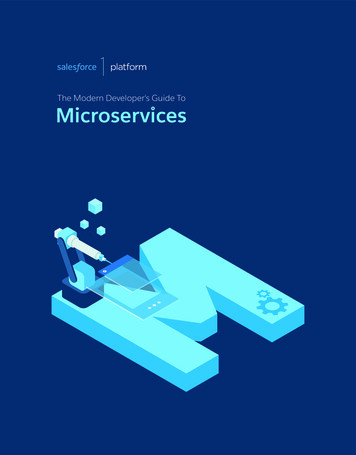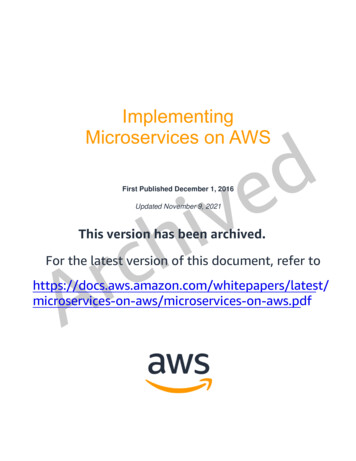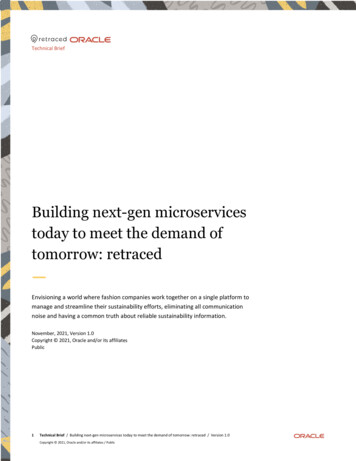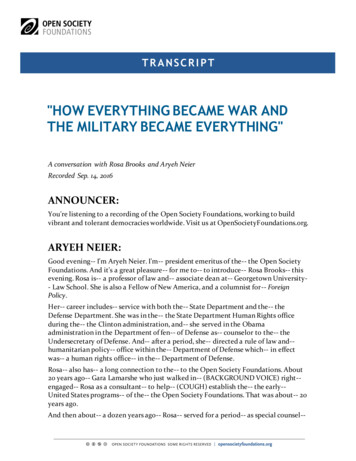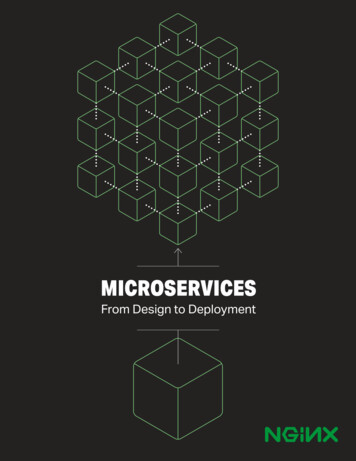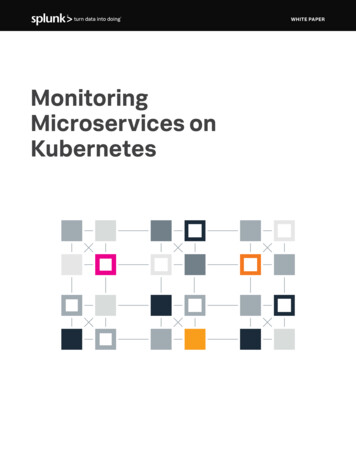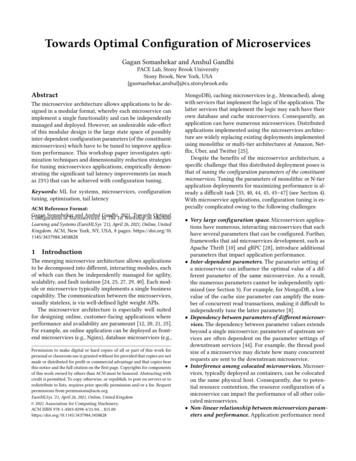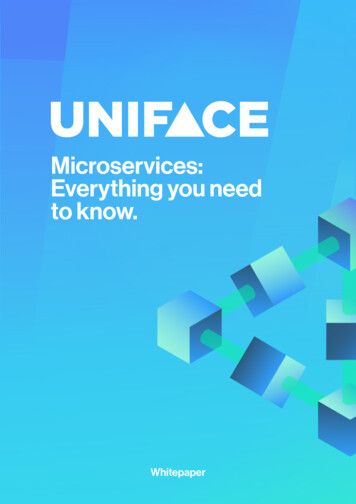
Transcription
Microservices:Everything you needto know.Whitepaper
Microservices: Everythingyou need to know.No better way of getting this fresh year started with a focus oninteresting trends and technologies. We start by having a better look atmicroservices.In what ways can microservices help your customers and how can youbenefit from microservices during application development?It’s time for a chat with Michael Taylor.What do microservices mean toyou?“Microservices offer an effective way to breakup your application in order to make themindependent and easier to scale. This way, yourapplication can meet the big scale needs ofmodern businesses these days.Microservices enable you to deliverapplications which are not only scalable, butalso stable. They offer the infrastructure inwhich you can deliver applications which last.Microservices really are popular withcontainerization because you don’t needbig virtual machines or bare metal to deployyour applications. Now you can put them intoorchestrated environments and get startedright away.”2About Michael TaylorMichael Taylor is aProduct Managerat Uniface. Michaelhas experience withUniface since 1993.He started on thehelpdesk and has beenthrough several jobroles, including presales, post-sales andconsultancy.Michael left for a whileand rejoined Unifacein 2008 to become asubject matter expert.In 2014, Michael movedto The Netherlandsto work in productmanagement.
Before we dive deeper into the architecture, in whatways can microservices help the end-customer?“If we look back in the history of application development, we are used toworking on monolithic applications. Applications which consisted of oneblock of code, sitting on a platform. In these cases, it’s possible to scaleby adding other platforms or by using a load balancer, but microservicesoffer a more sustainable way of working. With microservices you arebreaking up your application in common parts. Developers can identifythe different areas of concern and make sure these are developed,tested and deployed independently. In a sense, microservices give youmore control.You can have a part of an application with a high workload and whichhas to be scaled accordingly, while having another component which isused infrequently and as a result has different scalability requirements.With microservices, it is possible to break up the application in severalareas of concern, put clearly defined API’s around the individualcomponents and scale them to meet the business needs. When youlook at technologies in the cloud and orchestration, such as Kubernetes(an open-source system for automating deployment, scaling, andmanagement of containerized applications), you really can benefit fromthe flexibility microservices offer.”“Microservices really are popular withcontainerization because you don’t need big virtualmachines or bare metal to deploy your applications.”Why do microservices fit well within the Unifaceparadigm?“With microservices, you end up with loosely coupled areas withinyour application, connected by a lightweight protocol in betweenthem for communication between the individual services. Within3
the Uniface development framework, we already work with looselycoupled components. This means that you can define your servicesvia configuration. The ‘backbone’ – the communication path betweenthe different services – is already there and built in the genetics of theUniface applications. As a result, microservices really sit well within thisenvironment.”In what ways does Uniface support the use ofmicroservices?“Firstly, carefully consider your application. You want to create areas ofyour application where one service is responsible for maintenance ofthat information. All of this is possible within the Uniface environment. Atthe same time, you can share components between subsystems. WithUniface applications developers are able to define the architecture atdeployment rather than in development time. It optimizes your ability tochange and makes it easier to keep up with your business needs.”As a Uniface developer, what skills and concepts can Iuse to fully benefit from microservices?“You need to be able to model your information and to maintain yourapplications. Next, you can break your application database up intoseparate databases so they get along with the microservices, etcetera. All these steps are basically the standard Uniface developmentparadigm. It’s just the question of breaking your application up in severalcomponents.We have long promoted a service-oriented architecture in which youmove your business logic out of the end component into a back-endservice and the same way of thinking applies to microservices. You knowhow to create a subsystem in Uniface, are able to create a clear API onit and have that API talk into a specific database. Also, you know how to4
move it and to deploy it across multiple platforms. Uniface has alwaysoffered the Uniface Request Broker (URB) in the background whichoffers you that communication between the different services. So in thatsense, the way of thinking is there already. Furthermore, containerizationplatforms such as Docker mean that you can encapsulate theapplication subsystem in a lightweight fashion. Before you might had iton multiple virtual machines, but they were much heavier.”To what extent can I re-use my existing code in order touse microservices?“You probably don’t need to re-develop your whole application. The logicalready is available, the same goes for the business knowledge. Youcan remove that and locate it in common areas, rather than rewrite it. Ofcourse, there may be some re-architecting and refactoring necessary.But the logic is still there and still accessible.”“With microservices, you end up with looselycoupled areas within your application, connectedby a lightweight protocol in between them forcommunication between the individual services.Within the Uniface development framework, wealready work with loosely coupled components.”What do I need in order to get started?“If you already are a Uniface developer you have everything in place toget started. You need a development license which you can get throughyour normal development license or via the Community Edition and youcan start creating your Uniface applications. Think about how you wantto structure your application. When starting with microservices, you5
want to have shared services. Example: you don’t want to have everysingle service to do its own authentication. Instead, build a service whichhandles all authentication and use something like JSON web tokensto pass between the different services to show that you have beenauthenticated. Another aspect you might want to consider is logging. Ifyou have a request coming in, it might be directed across multiple webservices. You want to collect that into a single environment in which youcan see how that behaves across all the different services rather thandigging into each one.Your application might need to be augmented with some extras in orderto be able to understand what’s going on and get the full benefit out ofit. Another great benefit of breaking it up is that you end up with domainexperts in particular areas of your application. So you can progress onesubsystem and the others can use it when ready, rather than havingto do everything at the same time. This way, you are dealing in a muchsmaller area and you are developing in that small area. This means thatthe changes are probably smaller, it’s more testable, and you end up withan agile way of working.”Now it’s your turn to get startedUniface has a proven track record and leads the way for model-driven,low-code application development and deployment software forenterprise businesses, software integrators and ISVs.Accelerate innovation with Uniface’s low-code platform and find outwhat’s new in Uniface 10 Community Edition.To get a head start, visit the free eLearning academy and have a look atthe repositories on Github and library code in the Uniface community.6
by adding other platforms or by using a load balancer, but microservices offer a more sustainable way of working. With microservices you are breaking up your application in common parts. Developers can identify the different areas of concern and make sure these are developed, tested and deployed independe
